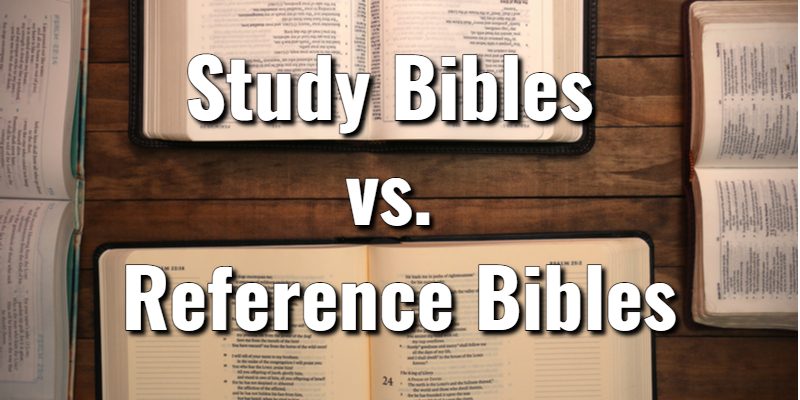Attempting to study the Bible as a new Christian can be a complicated and sometimes overwhelming process. After all, when you study the Bible, you are reading an ancient text that was written to an ancient audience. Attempting to unlock Biblical context in this way can be difficult. Thankfully, there are a wide variety of tools available to help Christians study, and they can mean all the difference during those critical first steps. It’s with these things in mind that the editors at Lord’s Library decided to explore various resource Bible types by comparing study Bibles vs. reference Bibles. The question is, what is the difference between the two, and which one is right for your study of the Holy Scriptures?
Study Bibles vs. Reference Bibles
What are Study Bibles? Study Bible Definition
Since the Bible was written long ago, context is key during any study of the Scriptures. There is vast historical, cultural, geographical, and Biblical context to take into consideration when interpreting the Word of God. To meet the goal of aiding a Bible student, study Bibles offer copious amounts of extra information that can help the reader understand more about the verse of passage they are studying.
In this way, study Bibles are Bibles that are specifically purposed for in-depth study of the Bible. Study Bibles commonly include the historical context in order to give the reader a more clear picture. On every page, there are notes for each verse that help to explain unfamiliar words or ideas. Of course, study Bible notes are written by humans and shouldn’t be considered as Scripture, but they can nonetheless be very helpful when one gets stuck trying in interpretation.
Study Bibles may also feature other helpful study tools like maps and architectural recreations that help readers step back in time to visualize what Christians of that day saw. For example, when the Bible talks about the tabernacle or the temple, most study Bibles will insert an image of what historians believed the tabernacle and temple to actually look like.
Study Bibles include introductions to each book of the Bible, detailing its authorship, time period, and other details that help the reader to better understand where that book fits in the biblical narrative. They can include a concordance to aid the reader in understanding certain biblical words or phrases as well.
Study Bibles Defined
What are Reference Bibles? Reference Bible Definition
Like study Bibles, reference Bibles seek to aid readers in understanding the Scriptures more clearly. Whereas study Bibles offer outside study notes via authors commenting on the Scriptures, reference Bibles point you in the direction of additional Bible verses themselves for guidance.
For many verses in the Bible, there is a cross-reference. A cross-reference is a reference to another verse or passage that can aid in the understanding of the original. These will point to verses that share a similar theme, idea, or concept. Cross-references also serve an important purpose in the New Testament due to the number of times the Old Testament is quoted in the New Testament. Cross-references would exist for those quoted verses that point back to the Scriptures in the Old Testament.
For example, in Mark 10:6-9, Jesus says, “But from the beginning of the creation God made them male and female. For this cause shall a man leave his father and mother, and cleave to his wife; And they twain shall be one flesh: so then they are no more twain, but one flesh. What therefore God hath joined together, let not man put asunder.” This is a reference to the Old Testament passages Genesis 1:27 and 2:24 which say, “So God created man in his own image, in the image of God created he him; male and female created he them.” and, “Therefore shall a man leave his father and his mother, and shall cleave unto his wife: and they shall be one flesh.”
In a reference Bible, there would be a link between these three verses to show that they are speaking of the same thing.
Reference Bibles don’t only do this with quotes, they also categorize passages by subject matter. That way, when you are researching a specific topic, you can see all the different verses that speak on it.
Reference Bibles Defined
Study Bibles vs. Reference Bibles; What’s the Difference?
Study Bibles and reference Bibles differ through their focus of expertise. While study Bibles provide the reader with a broad range of information through images, maps, and external commentaries, reference Bibles aim to tie the Scriptures together so they become grouped in a way that adds contextual insight.
When comparing study Bibles vs. reference Bibles, it’s important to know that both resource types are designed to help Christians interpret the Bible. And both remain excellent Bible study tools depending on your purpose. Knowing their differences, both resources deserve a spot on your bookshelf. One can never have too many Bible tools, and both are worth exploring as additions regardless of your comfortability with the Scriptures.
Lord's Library participates in affiliate programs. We may make a small commission from products purchased through this resource.
- What Does the Bible Say About Discernment? With Key Scriptures - July 19, 2024
- What Does the Bible Say About Disobedience? With Key Scriptures - July 19, 2024
- 1 Timothy 1:12 Meaning: Commentary on an Important Scripture - July 11, 2024












